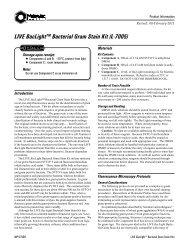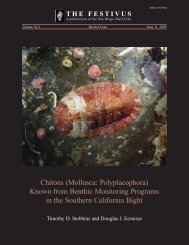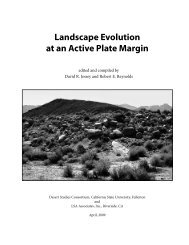Vertical Vegetation Structure Below Ground: Scaling from Root
Vertical Vegetation Structure Below Ground: Scaling from Root
Vertical Vegetation Structure Below Ground: Scaling from Root
Create successful ePaper yourself
Turn your PDF publications into a flip-book with our unique Google optimized e-Paper software.
<strong>Vertical</strong> <strong>Vegetation</strong> <strong>Structure</strong> <strong>Below</strong> <strong>Ground</strong>: <strong>Scaling</strong> <strong>from</strong> <strong>Root</strong> to Globe 365of nutrient and water uptake (Casper et al. 2003) and inverse modelingapproaches that calculate root function <strong>from</strong> changes in the distribution ofsoil resources (Adiku et al. 2000; Hupet et al. 2003). The greatest challengein root research remain mycorrhizae and their effects on root distributionand function. The vertical distribution of mycorrhizal hyphae below theupper soil layers is an open research question for most terrestrial ecosystems(Rosling et al. 2003).Ecologists cannot be accused to ever ‘scoff at what their eyes cannot see’– to paraphrase the German poet Matthias Claudius – but too often in thepast have they ignored what their eyes did not see. Too often the soilremains the black box of studies in terrestrial ecology (Hammer 1998). Thevisible and hidden halves of plants,of vegetation,and of ecosystems deserveand need equal attention.Acknowledgements. The author wishes to thank Susan Schwinning and David Robinson forhelpful comments on the manuscript and Laura Middlebrooke for help with data processing.This research was made possible in part by a postdoctoral fellowship <strong>from</strong> the NationalCenter for Ecological Analysis and Synthesis [a Center funded by NSF (DEB-94-21535),theUniversity of California at Santa Barbara,and the State of California] and by a grant <strong>from</strong>the Andrew W. Mellon Foundation.ReferencesAdiku SGK,Braddock RD,Rose CW (1996) Modelling the effect of varying soil water on rootgrowth dynamics of annual crops. Plant Soil 185:125–135Adiku SGK, Rose CW, Braddock RD, Ozier-Lafontaine H (2000) On the simulation of rootwater extraction: examination of a minimum energy hypothesis. Soil Sci 165:226–236Anten NPR,Hirose T (2001) Limitations on photosynthesis of competing individuals instands and the consequences for canopy structure. Oecologia 129:186–196Bais HP,Vepachedu R,Gilroy S,Callaway RM,Vivanco JM (2003) Allelopathy and exoticplant invasion: <strong>from</strong> molecules and genes to species interactions. Science 301:1377–1380Baitulin IO (1979) Kornevaja sistema rastenij aridnoj zony Kazakhstana (in Russian). (<strong>Root</strong>systems of plants of the arid zone of Kazakhstan) Nauka, Alma-AtaBaitulin IO (ed) (1993) Fitoékologicheskie issledovanija v juzhnoj Gobi (in Russian withEnglish summary). (Phytoecological investigations in southern Gobi) Gylim,Alma-AtaBaligar VC,Fageria NK,Elrashidi MA (1998) Toxicity and nutrient constraints on rootgrowth. HortScience 33:960–965Ball-Coelho BR, Roy RC, Swanton CJ (1998) Tillage alters corn root distribution in coarsetexturedsoil. Soil Till Res 45:237–249Benasher J,Silberbush M (1992) <strong>Root</strong> distribution under trickle irrigation – factors affectingdistribution and comparison among methods of determination. J Plant Nutr 15:783–794Bengough AG (2003) <strong>Root</strong> growth and function in relation to soil structure,composition,and strength. In: de Kroon H,Visser EJW (eds) <strong>Root</strong> ecology,vol 168. Springer,BerlinHeidelberg New York,pp 151–171Bingham IJ,Bengough AG (2003) Morphological plasticity of wheat and barley roots inresponse to spatial variation in soil strength. Plant Soil 250:273–282Biondini M (2001) A three-dimensional spatial model for plant competition in an heterogeneoussoil environment. Ecol Model 142:189–225
















